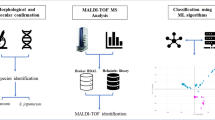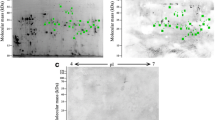Abstract
Oncomelania hupensis snails along the Yangtze River and the low positive rate and infectiosity of human and livestock schistosomiasis still pose a threat to public health in China. Adult blood flukes were recognized as Schistosoma japonicum, which are found in the portal system of the sentinel mice bred in the laboratory for 35 days after contact with the water. However, 35 days was too long from the field test to dissection, and the dissection in the laboratory was also time-consuming and labor-intensive. Serum peptides in mice at different times after infection were measured by matrix-assisted laser desorption/ionization time-of-flight mass spectrometry. ClinProTool was used to establish the proteomic detection pattern (PDP), based on the differentially expressed peptide between the infection and healthy control groups. Under experimental conditions, characteristic PDP were detected in 5 % (3/60), 35 % (21/60), 75 % (45/60), 87.93 % (51/58), and 98.15 % (53/54) of infected mice from weeks 1 to 5 post-infection, whereas ELISA and dissection examination for adult blood flukes missed the first 2 weeks. At 35 days post-infection, the infectiosity assay showed 40 % (4/10), 50 % (5/10), and 80 % (8/10) positivity with the PDP test in mice infected with 4, 6, and 10 cercariae, respectively, as well as 100 % (10/10) positivity in mice infected with 14, 18, and 22 cercariae. Five stored sera of positive sentinel mice with parasite detection were verified correctly in the PDP test. The results confirm that PDP can be used as a rapid and early detection method for S. japonicum infection in experimental mice, which are expected to apply in early surveillance for schistosomiasis.



Similar content being viewed by others
References
Bergquist R, Yang GJ, Knopp S, Utzinger J, Tanner M (2015) Surveillance and response: tools and approaches for the elimination stage of neglected tropical diseases. Acta Trop 141(Pt B):229–34
Bregeon F et al (2014) MALDI-ToF mass spectrometry for the rapid diagnosis of cancerous lung nodules. PLoS One 9(5):e97511
Cai YC et al (2014) Field comparison of circulating antibody assays versus circulating antigen assays for the detection of schistosomiasis japonica in endemic areas of China. Parasites Vectors 7:138
Carlton EJ, Bates MN, Zhong B, Seto EY, Spear RC (2011) Evaluation of mammalian and intermediate host surveillance methods for detecting schistosomiasis reemergence in southwest China. PLoS Negl Trop Dis 5(3):e987
Chaiyarit P, Taweechaisupapong S, Jaresitthikunchai J, Phaonakrop N, Roytrakul S (2015) Comparative evaluation of 5-15-kDa salivary proteins from patients with different oral diseases by MALDI-TOF/TOF mass spectrometry. Clin Oral Investig 19(3):729–37
Chen JH et al (2012) Frontiers of parasitology research in the People’s Republic of China: infection, diagnosis, protection and surveillance. Parasites Vectors 5:221
Chen R et al (2008) Evaluation of a rapid ELISA technique for detection of circulating antigens of Toxoplasma gondii. Microbiol Immunol 52(3):180–7
de la Torre-Escudero E, Perez-Sanchez R, Manzano-Roman R, Oleaga A (2015) Schistosome infections induce significant changes in the host biliary proteome. J Proteomics 114:71–82
Gao FH et al (2014) Fine scale spatial-temporal cluster analysis for the infection risk of Schistosomiasis japonica using space-time scan statistics. Parasites Vectors 7:578
Golde WT, Gollobin P, Rodriguez LL (2005) A rapid, simple, and humane method for submandibular bleeding of mice using a lancet. Lab animal 34(9):39–43
Hu Y et al (2014) Expression profiles of glyceraldehyde-3-phosphate dehydrogenase from Clonorchis sinensis: a glycolytic enzyme with plasminogen binding capacity. Parasitol Res 113(12):4543–53
Huang Y et al (2011) Proteomic patterns as biomarkers for the early detection of schistosomiasis japonica in a rabbit model. Int J Mass Spectrom 299(2–3):191–195
Hung YW, Remais J (2008) Quantitative detection of Schistosoma japonicum cercariae in water by real-time PCR. PLoS Negl Trop Dis 2(11):e337
Karpova MA, Moshkovskii SA, Toropygin IY, Archakov AI (2010) Cancer-specific MALDI-TOF profiles of blood serum and plasma: biological meaning and perspectives. J Proteomics 73(3):537–51
Ketterlinus R, Hsieh SY, Teng SH, Lee H, Pusch W (2005) Fishing for biomarkers: analyzing mass spectrometry data with the new ClinProTools software. Biotechniques Suppl Suppl:37–40
Li H et al (2015) Elimination of schistosomiasis japonica from formerly endemic areas in mountainous regions of southern China using a praziquantel regimen. Vet Parasitol 208(3-4):254–8
Liang YS et al (2011) A strategy for emergency treatment of Schistosoma japonicum-infested water. Parasites Vectors 4:209
Liu J et al (2012) Decreased serum levels of nucleolin protein fragment, as analyzed by bead-based proteomic technology, in multiple sclerosis patients compared to controls. J Neuroimmunol 250(1-2):71–6
Long L, Li R, Li Y, Hu C, Li Z (2011) Pattern-based diagnosis and screening of differentially expressed serum proteins for rheumatoid arthritis by proteomic fingerprinting. Rheumatol Int 31(8):1069–74
Makioka A, Kumagai M, Kobayashi S, Takeuchi T (2007) Differences in protein profiles of the isolates of Entamoeba histolytica and E. dispar by surface-enhanced laser desorption ionization time-of-flight mass spectrometry (SELDI-TOF MS) ProteinChip assays. Parasitol Res 102(1):103–10
Musharraf SG, Hashmi N, Choudhary MI, Rizvi N, Usman A, Atta ur R (2012) Comparison of plasma from healthy nonsmokers, smokers, and lung cancer patients: pattern-based differentiation profiling of low molecular weight proteins and peptides by magnetic bead technology with MALDI-TOF MS. Biomarkers 17(3):223–30
Ndao M et al (2010) Identification of novel diagnostic serum biomarkers for Chagas’ disease in asymptomatic subjects by mass spectrometric profiling. J Clin Microbiol 48(4):1139–49
Nie G, Wang T, Lu S, Liu W, Li Y, Lei J (2014) Detection of Clonorchis sinensis circulating antigen in sera from Chinese patients by immunomagnetic bead ELISA based on IgY. PLoS One 9(12):e113208
Ning A et al (2015) Abnormal liver function in different patients with Schistosoma japonicum. Parasitol Res 114(1):85–90
Sauer A et al (2013) The local immune response to intraocular Toxoplasma re-challenge: less pathology and better parasite control through Treg/Th1/Th2 induction. Int J Parasitol 43(9):721–8
Shevchenko VE, Arnotskaya NE, Zaridze DG (2010) Detection of lung cancer using plasma protein profiling by matrix-assisted laser desorption/ionization mass spectrometry. Eur J Mass Spectrom (Chichester, Eng) 16(4):539–49
Singh R, Yadav BS, Singh S, Pandey PN, Mani A (2016) In-silico screening of Schistosoma mansoni sirtuin1 inhibitors for prioritization of drug candidates. SpringerPlus 5:286
Steinmann P, Keiser J, Bos R, Tanner M, Utzinger J (2006) Schistosomiasis and water resources development: systematic review, meta-analysis, and estimates of people at risk. Lancet Infect Dis 6(7):411–25
Steinmann P et al (2015) Control of soil-transmitted helminthiasis in Yunnan province, People’s Republic of China: experiences and lessons from a 5-year multi-intervention trial. Acta Trop 141(Pt B):271–80
Sun LP et al (2011) A Google Earth-based surveillance system for schistosomiasis japonica implemented in the lower reaches of the Yangtze River, China. Parasites Vectors 4:223
Wang H et al (2012) Surveillance and forecast of schistosomiasis based on sentinel mouse technique in key water regions of Wuhan City in 2011. Chin J Schisto Control 24(4):415–9
Wang WL, Tang JS, Xia DG, Zhang XZ (2001) A preliminary study on specific adult-antigens of Paragonimus proliferus. Chin J Parasit Dis Control 2:19–20
Yang K et al (2013) Schistosoma japonicum risk in Jiangsu province, People’s Republic of China: identification of a spatio-temporal risk pattern along the Yangtze River. Geospat Health 8(1):133–42
Zapico-Muniz E, Farre-Viladrich A, Rico-Santana N, Gonzalez-Sastre F, Mora-Brugues J (2010) Standardized peptidome profiling of human serum for the detection of pancreatic cancer. Pancreas 39(8):1293–8
Zhang JF et al (2016) Development and application of diagnostics in the national schistosomiasis control programme in the People’s Republic of China. Advances in parasitology 92:409–34
Zheng H et al (2013) Surveillance and response for schistosomiasis japonica based on sentinel mice examination for cercariae-infested water in risk region, 2012. Chin J Parasitol Parasit Dis 31(6):428–32
Zheng HA et al (2012) Surveillance and forecast of Schistosoma japonicum-infected sentinel mice in key water regions of China in 2010. Chin J Schisto Control 24(1):5–9
Zhu YC et al (2005) Application of dipstick dye immunoassay (DDIA) kit for the diagnosis of schistosomiasis mekongi. Acta Trop 96(2-3):137–41
Zou L, Ruan S (2015) Schistosomiasis transmission and control in China. Acta Trop 143C:51–57
Acknowledgments
We thank Leping Sun, Yunyi Yao, Jianfeng Zhang, Feng Wu, Song Zhao, Yongliang Xu, and Ying Zhang of the Jiangsu Institute of Parasitic Diseases for technical assistance.
Authors’ contributions
YH, WL, KL, PC, and JT conceived and designed the experiments; YH, WL, and CX performed the experiments; YH and WL analyzed the data; YH, WL, KL, PC, and JT contributed reagents/materials/analysis tools; and YH wrote the paper, All the authors read and approved the final manuscript.
Author information
Authors and Affiliations
Corresponding authors
Ethics declarations
Ethical statement
All the experiments described here fully complied with current national and institutional regulations and the Guidelines for the Care and Animal Procedures approved by the Institutional Animal Care and Use Committee of Jiangsu Institute of Parasitic Diseases (JIPD), Jiangsu Province Academy of Traditional Chinese Medicine, and the Ministry of Science and Technology of the People’s Republic of China (Permit No. [2006]398).
Competing interests
The authors declare that they have no competing interests.
Funding
This study was supported by the Natural Science Foundation of China (grant no. 31201893), the Special Program of Jiangsu Clinical Medicine (grant no. BL2014020), Jiangsu Province’s Key Medical Centre (grant no. 201108), the Natural Science Foundation of Jiangsu Province (grant no. BK2011164), the Jiangsu Health Science Project (grant nos. X201416, X201110, and X201505), the Project of Preventive Medicine Association of Jiangsu Province (grant no. Y2015071), the Open Project of Key Laboratory of Jiangsu Preventive Veterinary Medicine (grant no. K13045), the project of Jiangsu branch of CACMS (grant no. H1604), the Jiangsu Health International Exchange Program to Y Huang, and a pilot grant to K Liu from the Johns Hopkins University Malaria Research Institute. The funders had no role in study design, data collection, management, analysis and interpretation, decision to publish, as well as the preparation, review, or approval of this manuscript.
Additional information
Yuzheng Huang and Wei Li contributed equally to this work.
Electronic supplementary material
Below is the link to the electronic supplementary material.
Fig S1
Adult blood flukes examination in different infectiosity groups. (GIF 14 kb)
Fig S2
Number of parasite eggs in 1 g liver in different infectiosity groups. (GIF 15 kb)
Fig S3
ELISA test of 54 acute infection mice at 5 weeks post-infection. 54 samples (A1–E6), positive control (E7, 8), negative control (E9, 10), blank control (E11, 12), healthy controls (F1–G8). (GIF 994 kb)
Rights and permissions
About this article
Cite this article
Huang, Y., Li, W., Liu, K. et al. New detection method in experimental mice for schistosomiasis: ClinProTool and matrix-assisted laser desorption/ionization time-of-flight mass spectrometry. Parasitol Res 115, 4173–4181 (2016). https://doi.org/10.1007/s00436-016-5193-0
Received:
Accepted:
Published:
Issue Date:
DOI: https://doi.org/10.1007/s00436-016-5193-0




